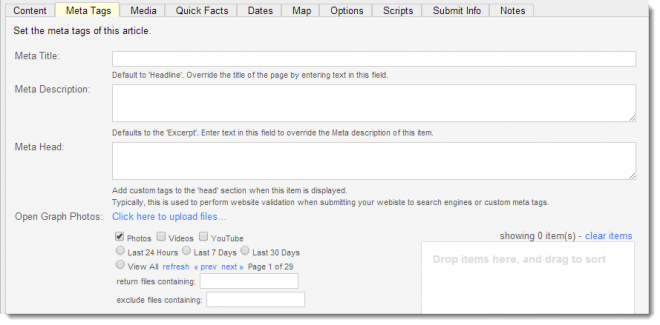All Tasks > Article Module > Articles
Search Engine Optimization (SEO) addresses how your content is found by visitors and whether those visitors become prospective consumers - a process known as conversion. The goal of SEO is to influence the ranking of your page in search engines (Like Google or Bing) for specific search queries.
Meta Title and Meta Descriptions displayed in a search

Maximizing SEO for Individual Articles
The CMS supplies a Meta Title and Meta Description at the global website level, but there are many other options, such as using article tags, to maximize and fine-tune your “searchability.”
From the Create Article screen, Click on the Meta Tags Tab

| Tab | Fields | Entry Instructions | Use For | Required |
| Meta Tags Tab | ||||
| Meta Title | Very important for SEO / Google searches. Article-level meta titles enable your article to be found more effectively in searches; they correspond to Google’s blue links in search results. (Notice the blue Meta Title in the example above) The Meta Title should briefly describe what the article is about. Use a keyphrase in your title corresponding to a phrase most people are likely to type to find your content. You can use Google Adwords tools to help you determine which phrases are effective. Keep to to 60 or fewer characters. | All article types | ||
| Meta Description | Important option for SEO. The Meta Description provides additional article level information so your article can be found in searches; it corresponds to the text that is displayed under the blue link in Google search results. Describe what the article is about in about 2 sentences or 150 characters. | All article types | ||
| Meta Head | Add custom tags to the "head" section to integrate third party applications or provide site verification. | |||
| Open Graph Photo | If you share this article's URL on social media networks like Linked In or Facebook, open graph will take the photo you select here as the thumbnail for your link, as opposed to the first image they find on the page (like the company logo). Select and drag the single image you want to use into the white box. | |
||
Maximize your Meta title & Description by learning more about keywords here. Identifying Keywords
Leveraging URLs for SEO
The LVSYS CMS allows you to set short URLS for articles and products. Maximize the opportunity by creating short, descriptive URLs containing keywords. If you sell candles, an article URL of new-fragrance-free-candles is more beneficial than new-products.
Maximizing Headings (H1 tags) for SEO
The Headline field in articles, events, products and business listings is the H1 tag and provides a great opportunity to reinforce and maximize SEO. Reveiw these recommendations for using Headlines to enhance SEO:
- A Headline is required. Create a Headline relevant to your article, event, etc. Don’t use a generic heading.
- Do not try to trick search engines by using a headline that is irrelevant to your content. For example, a winery website using a headline to promote the benefits of a pharmaceutical drug can be red-flagged by search engines.
HTML restricts each page to one H1 tag, so take advantage of this opportunity to maximize SEO by using a relevant and descriptive headline.
Maximizing SEO for Article Categories
If you use category pages to display your articles in hyperlinked lists, there are SEO options you can define to maximize your SEO for the category. Click on the Meta Tags tab in each category to specify the Meta Title and Description.

